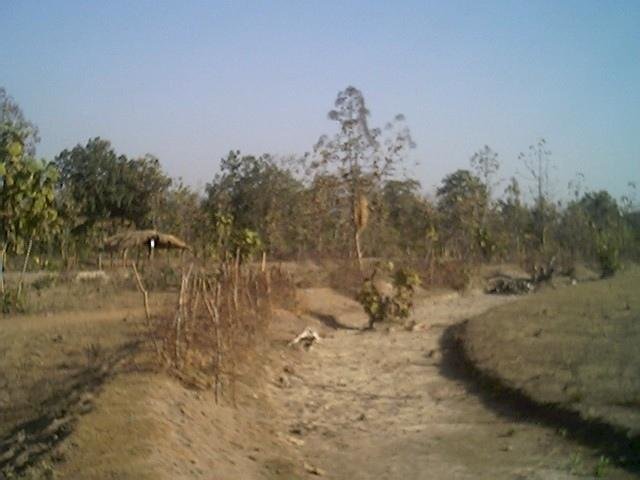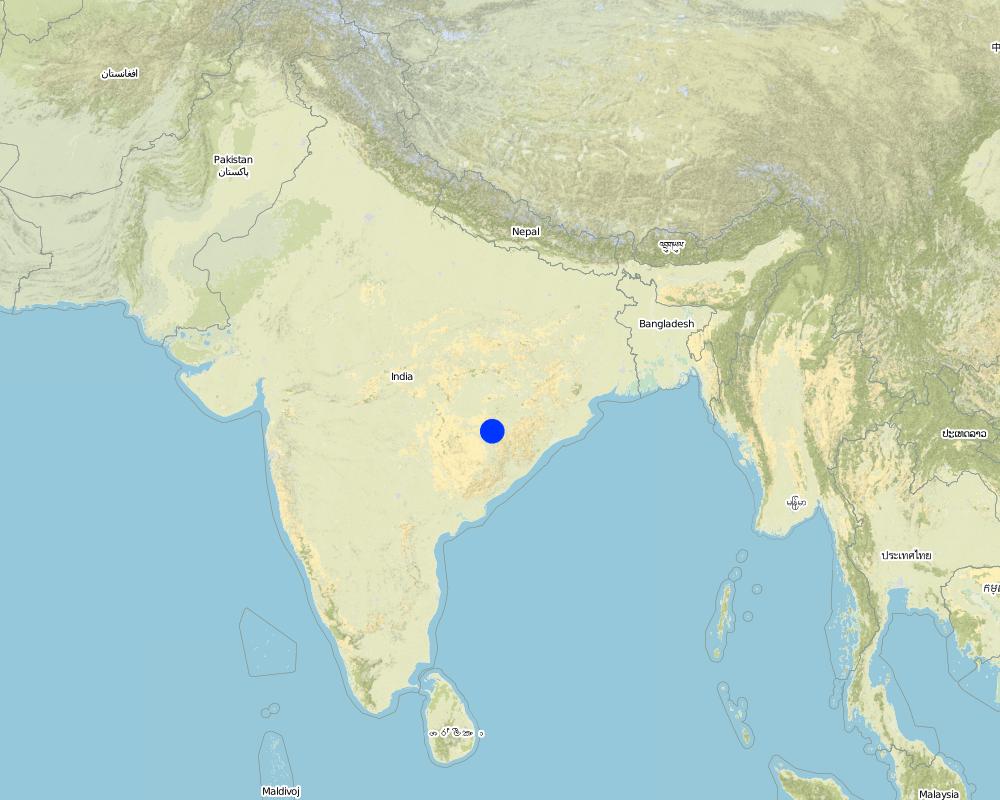Participatory Sustainable Rural Livelihood Approach [อินเดีย]
- ผู้สร้างสรรค์:
- การอัพเดท:
- ผู้รวบรวม: Niranjan Sahu
- ผู้เรียบเรียง: –
- ผู้ตรวจสอบ: Fabian Ottiger
approaches_2367 - อินเดีย
ดูส่วนย่อย
ขยายทั้งหมด ย่อทั้งหมด1. ข้อมูลทั่วไป
1.2 รายละเอียดที่ติดต่อได้ของผู้รวบรวมและองค์กรที่เกี่ยวข้องในการประเมินและการจัดเตรียมทำเอกสารของแนวทาง
ผู้เชี่ยวชาญ SLM:
ชื่อของโครงการซึ่งอำนวยความสะดวกในการทำเอกสารหรือการประเมินแนวทาง (ถ้าเกี่ยวข้อง)
Orissa Watershed Developemnt Mission - อินเดีย1.3 เงื่อนไขที่เกี่ยวข้องกับการใช้ข้อมูลที่ได้บันทึกไว้ผ่านทาง WOCAT
ผู้รวบรวมและวิทยากรหลักยอมรับเงื่อนไขเกี่ยวกับการใช้ข้อมูลที่ถูกบันทึกผ่านทาง WOCAT:
ใช่
1.4 การอ้างอิงถึงแบบสอบถามเรื่องเทคโนโลยี SLM

Contour Trench cum Bund [อินเดีย]
Contour trench cum bund is a bund laid out on contour along with trench either staggered or continuous to check the velocity of run off, conserve in situ moisture, increse ground water recharge and there by establish a sustainable land use system.
- ผู้รวบรวม: Niranjan Sahu
2. คำอธิบายของแนวทาง SLM
2.1 การอธิบายแบบสั้น ๆ ของแนวทาง
Participatory Sustainable Rural Livelihood Approach adopts participatory tools for livelihood situational analysis of the five capitals(Physical, Financila,Social, Human and Natural) and prepare livelihood focussed micro plan with the commuity for sustai
2.2 การอธิบายอย่างละเอียดของแนวทาง
การอธิบายอย่างละเอียดของแนวทาง:
Aims / objectives: Participatory Sustainable Rural Livelihood Approach uses the DFID's Sustainable Rural Livelihood Framework. The approach adopts participatory processes during planning, implementation, monitoring and evaluation.The out put of the planning process is a livelihood focussed micro plan. The process of micro plan preparation with the community consists of rapport building, livelihood situational analysis, problem identification and prioritisation, negotiation and development of action plan. The livelihood situational analysis focuses on identifying the strength of the community by diagonising the five capitals(Physical, Natural, Financial, Social, Human) and suggest options for livelihood improvement. Objective: 1.Livelihood improvement of the poor and vulnerable.2. Creating an enabling environment 3. Capacity building of the primary and secondary stake holders.Out puts:1.Enhanced and sustainable livelihood options for resource poor and disadvantaged identified and supported in project areas. 2.Resource poor and disadvantaged organised in project areas to effectively identify, plan and implement livelihood activities and participate in wider for a and processes.3.GO,PRI, NGO,PIA work effectively with communities on (pro poor) livelihoods and initiatives in four project districts. 4.Strategic constraints to livelihood of resource poor and disadvantaged are identified and reviewed and improvements proposed to Government.5.Appropriate approaches and interventions developed through the project are replicated in the four project districts and disseminated within Orissa and national level for a.
Methods: Participatory, Collaborative and Convergence. Stages of implementation: Rapport building,Community mobilistion, Preparation of micro plan, Formation of village level institutions, implementation, monitoring and evaluation.
Role of stakeholders: Community members are actors and all others are facilitators.
2.5 ประเทศ ภูมิภาค หรือสถานที่ตั้งที่ได้นำแนวทางไปใช้
ประเทศ:
อินเดีย
ภูมิภาค/รัฐ/จังหวัด: :
Orissa
Map
×2.6 วันที่เริ่มต้นและสิ้นสุดของแนวทาง
ระบุปีที่เริ่ม:
2002
การสิ้นสุดลง (ถ้าแนวทางไม่ได้ใช้อีกต่อไป):
2010
2.7 ประเภทของแนวทาง
- ใช้โครงงานหรือแผนงานเป็นฐาน
2.8 เป้าหมายหรือวัตถุประสงค์หลักของแนวทาง
The Approach focused mainly on SLM with other activities (Promotion of tuber crops for food security, Participatory technology development, Livestock management, Grassroot institutions building,Microenterprise development through Self Help Groups, Policy advocacy,Adopt participatory processes)
1.Livelihood of the poorest improved in four districts in a sustainable and replicable way.2.WORLP will provide ENABLING ENVIRONMENT to initiate this experiment.3.Bring about a clear understanding of-what is watershed- (emphasizing equity, social justice and local government / PRI).4.develop a synergistic strategy.5.Orient agencies to work towards the synergistic strategy- capacity building.5.Create and strengthen appropriate institutions at different levels for implementing and monitoring common strategy. 6.Pursue necessary policy change in regards to fund management and inter-department, inter-agency coordination.7.At the grassroots level i.e., watershed level demonstrate convergence of activities.
The SLM Approach addressed the following problems: Capacity building(Knowledge, skill and attitude) of the primary and secondary stake holders.Limited livelihood options.Sectoral approach by line departments.
2.9 เงื่อนไขที่เอื้ออำนวยหรือเป็นอุปสรรคต่อการนำเทคโนโลยีภายใต้แนวทางนี้ไปปฏิบัติใช้
บรรทัดฐานและค่านิยมทางสังคม วัฒนธรรม ศาสนา
- เป็นอุปสรรค
Skewed distribution of weath, Community management of natural resources
Treatment through the SLM Approach: Identify well being groups,Promote communty farming, Capacity building on CPR management
การมีไว้ให้หรือการเข้าถึงแหล่งการเงินและบริการ
- เป็นอุปสรรค
Poor affordibility of farmers and ownership
Treatment through the SLM Approach: Financial aid to farmers through WC, SHG and UG. Voluntary contribution to create a sense of ownership
การจัดตั้งระดับองค์กร
- เป็นอุปสรรค
Poor grass root institutions
Treatment through the SLM Approach: Strengthening of existing institutions and promotion of WC, SHG, UG and CIG
กรอบแนวทางในการดำเนินการด้านกฎหมาย (การถือครองที่ดิน สิทธิในการใช้ที่ดินและน้ำ)
- เป็นอุปสรรค
The existing land ownership, land use rights / water rights hindered a little the approach implementation Due to small land holding
ความรู้เกี่ยวกับ SLM การเข้าถึงการสนับสนุนด้านเทคนิค
- เป็นอุปสรรค
poor knowledge on land and water management practices
Treatment through the SLM Approach: In-field training and demonstration, exposure, development of NRM volunteers
3. การมีส่วนร่วมและบทบาทของผู้มีส่วนได้ส่วนเสียที่เกี่ยวข้อง
3.1 ผู้มีส่วนได้ส่วนเสียที่เกี่ยวข้องในแนวทางนี้และบทบาท
- ผู้ใช้ที่ดินระดับท้องถิ่นหรือชุมชนระดับท้องถิ่น
Village level institutions like WC,SHG,UG,CIG etc.
Working land users were mainly men (mainly main supported by women). Men participate more in WC and UG meetings where as women participate in SHG meetings. The no of women in UG is also less. Decision making is mainly done by men on SWC technology. The resource poor land user is also a member of the UserGroup. So, he/She participate in the meetings and share his/her views.
- องค์กรพัฒนาเอกชน
- รัฐบาลแห่งชาติ (ผู้วางแผน ผู้ทำการตัดสินใจ)
MoRD,GoI; OWDM,MoA,GoO
- องค์การระหว่างประเทศ
DFID,UK
3.2 การเกี่ยวข้องของผู้ใช้ที่ดินระดับท้องถิ่นหรือชุมชนระดับท้องถิ่นในช่วงต่างๆของแนวทาง
| ความเกี่ยวข้องของผู้ใช้ที่ดินระดับท้องถิ่นหรือชุมชนระดับท้องถิ่น | ระบุผู้ที่มีส่วนเกี่ยวข้องและอธิบายกิจกรรม | |
|---|---|---|
| การริเริ่มหรือการจูงใจ | ปฏิสัมพันธ์ | Exposure visit and demonstration; Approach is initiated with rapport building stage through small interactive meeting, conducting mapping exercises and focussed group discussion to understand the village situation.Exposure and demonstration help the land users to identify gaps in the existing and im |
| การวางแผน | ปฏิสัมพันธ์ | Mainly: rapid/participatory rural appraisal; partly: public meetings; 1.For livelihood situational analysis. 2. Focussed Group discussion for indepth analyis of constraints and oppertunities of a particular group.3. Palli Sabha to negotiate and obtain a consensus on the plan. |
| การดำเนินการ | จ่ายเงินหรือสนับสนุนจากภายนอก | Mainly: responsibility for major steps; partly: responsibility for minor steps; Implementation of the programme is the prime responsibility of the user group.NRM volunteers are assisting the UG on technical guidance like laying contours, bunds and trenches.Involved landless during the implementation |
| การติดตามตรวจสอบหรือการประเมินผล | ระดมกำลังด้วยตนเอง | Mainly: measurements/observations; partly: reporting; Watershed Development Team member and WC check measure the work before payment. The report submitted by the WC is reviewed by the Project implementing agency(PIA). The estimated cost is approved by the committee and then the expenditure is made. |
| Research | ไม่มี |
3.4 การตัดสินใจเลือกใช้เทคโนโลยี SLM
ระบุผู้ที่ทำการตัดสินใจเลือกเทคโนโลยีมากกว่าหนึ่งวิธีไปปฏิบัติใช้:
- ผู้ใช้ที่ดินเป็นผู้ตัดสินใจหลัก โดยการสนับสนุนจากผู้เชี่ยวชาญ SLM
การอธิบาย:
Interventions promoted mainly on the existing indegeneous practices and based on peoples strength.
Decisions on the method of implementing the SLM Technology were made by mainly by land users supported by SLM specialists. The technical knowhow was transferred to the NRM volunteers and land users through training and demonstration Then the volunteer assisted the land users in developing proposal and implementation of the SWC Technology.
4. การสนับสนุนด้านเทคนิค การสร้างขีดความสามารถ และการจัดการด้านความรู้
4.1 การสร้างขีดความสามารถ / การอบรม
ได้มีการจัดอบรมให้แก่ผู้ใช้ที่ดินหรือผู้มีส่วนได้ส่วนเสียคนอื่น ๆ หรือไม่:
ใช่
ให้ระบุว่าใครเป็นผู้ได้รับการอบรม:
- ผู้ใช้ที่ดิน
- extensionists/trainers (2), SWC specialists (3)
รูปแบบการอบรม:
- กำลังดำเนินการ
- เกษตรกรกับเกษตรกร
- ใช้พื้นที่ทำการสาธิต
หัวข้อที่พูด:
Understanding of present land use and future treatment measures, determination of slope, use of tools like A frame, hand level, layout of contours, trench and bund, role of UG etc.
4.2 การบริการให้คำแนะนำ
ผู้ใช้ที่ดินมีการเข้าถึงการรับบริการให้คำปรึกษาหรือไม่:
ใช่
ระบุว่ามีบริการให้คำปรึกษาหรือไม่:
- ไปเยี่ยมชมสถานที่
การอธิบาย/แสดงความคิดเห็น:
Name of method used for advisory service: Participatory technology development, field demonstration, exposure visits and in field training; Key elements: Use of participatory tools, NRM volunteers, Insitu training, demonstration and exposure visits; 1) Mainly: NRM volunteers, Partly: projects own extension structure and agent 2) Mainly: NRM volunteers, Partly: projects own extension structure and agent; Extension staff: specifically hired project employees 3) Target groups for extension: land users; Activities: Meeting, exposure,training and demonstration
Advisory service is inadequate to ensure the continuation of land conservation activities; Five NRM volunteers have been created in each watershed to assist in SWC work.Three WDT and three LST have been in position for extension and awareness creation among the land users for ten watersheds.
4.3 การเสริมความแข็งแกร่งให้กับสถาบัน (การพัฒนาองค์กร)
สถาบันได้รับการจัดตั้งขึ้นมาหรือเสริมความแข็งแกร่งโดยแนวทางนี้หรือไม่:
- ใช่ ปานกลาง
ระบุระดับของสถาบันที่ได้รับการเสริมความแข็งแกร่งหรือจัดตั้งขึ้นมา:
- ท้องถิ่น
ระบุประเภทของการให้ความช่วยเหลือสนับสนุน:
- ด้านการเงิน
- การสร้างขีดความสามารถ / การอบรม
4.4 การติดตามตรวจสอบและประเมินผล
การติดตามตรวจสอบและประเมินผลเป็นส่วนหนึ่งของแนวทางหรือไม่:
ใช่
ความคิดเห็น:
bio-physical aspects were ad hoc monitored through observations
technical aspects were regular monitored through observations
socio-cultural aspects were ad hoc monitored through observations
economic / production aspects were regular monitored through measurements
area treated aspects were regular monitored through observations
no. of land users involved aspects were regular monitored through measurements
management of Approach aspects were regular monitored through observations
There were several changes in the Approach as a result of monitoring and evaluation: Focussing the poorest through well being grouping for livelihood improvement, Grant component for the poorest earmarked in the livelihood guideline from watershed plus funds,Block approach for treatment considering poor people, poor land, contributiona nd ridge to valley, developed livelihood focussed micr plan process for the project.Transperency through social audit.
4.5 การวิจัย
การวิจัยเป็นส่วนหนึ่งของแนวทางหรือไม่:
ใช่
ระบุหัวข้อเรื่อง:
- เศรษฐศาสตร์หรือการตลาด
- เทคโนโลยี
ให้ข้อมูลเพิ่มเติมและให้ระบุผู้ทำการวิจัย:
Participatory technology development in farmers field.MART, New Delhi has taken up a six months study on developing marketing strategy.
Research was carried out on-farm
5. การสนับสนุนด้านการเงินและวัสดุอุปกรณ์
5.1 ระบุงบประมาณประจำปีสำหรับแนวทาง SLM นี้
ถ้าหากว่างบประมาณประจำปีไม่เป็นที่ทราบแน่นอน ให้ระบุช่วงลงไป:
- > 1,000,000
แสดงความคิดเห็น (แหล่งของการระดมทุน ผู้บริจาคคนสำคัญ):
Approach costs were met by the following donors: international (DFID,UK): 85.0%; local community / land user(s) (UG): 15.0%
5.2 การสนับสนุนด้านการเงิน / วัสดุอุปกรณ์ให้แก่ผู้ใช้ที่ดิน
ผู้ใช้ที่ดินได้รับการสนับสนุนด้านการเงิน / วัสดุอุปกรณ์ไปปฏิบัติใช้เทคโนโลยีหรือไม่:
ไม่ใช่
5.3 เงินสนับสนุนสำหรับปัจจัยนำเข้า (รวมถึงแรงงาน)
- ไม่มี
ถ้าแรงงานโดยผู้ใช้ที่ดินเป็นปัจจัยนำเข้าที่มีอยู่มากมาย ระบุด้วยว่าเนื่องจาก:
- จ่ายเป็นเงินสด
5.4 เครดิต
มีการจัดหาเครดิตมาให้ภายใต้แนวทาง SLM หรือไม่:
ไม่ใช่
6. การวิเคราะห์ผลกระทบและการสรุป
6.1 ผลกระทบของแนวทาง
ช่วยให้ผู้ใช้ที่ดินนำเอาเทคโนโลยี SLMไปใช้และบำรุงรักษาสภาพไว้ได้หรือไม่:
- ไม่ใช่
- ใช่ เล็กน้อย
- ใช่ ปานกลาง
- ใช่ อย่างมาก
treating the land from ridge to valley,reduced soil loss and sand casting in the down stream, increased moisture availabilty, water harvesting of the excess runoff,
ปรับปรุงประเด็นของการถือครองที่ดินหรือสิทธิในการใช้ ซึ่งขัดขวางการนำเทคโนโลยีไปใช้ให้ดีขึ้น:
- ไม่ใช่
- ใช่ เล็กน้อย
- ใช่ ปานกลาง
- ใช่ อย่างมาก
Working in group in a participatory manner has facilitated a process of identifying their own constraints and oppertunities and plan interventions accordingly, thus implamentation is more effective.
Did other land users / projects adopt the Approach?
- ไม่ใช่
- ใช่ เล็กน้อย
- ใช่ ปานกลาง
- ใช่ อย่างมาก
Adoption of the SRL approach and compact area treatment in non-WORLP watersheds in WORLP project districts.
6.3 ความยั่งยืนของกิจกรรมของแนวทาง
ผู้ใช้ที่ดินสามารถทำให้สิ่งต่างๆ ที่ได้ปฏิบัติใช้โดยแนวทางนี้ยั่งยืนได้หรือไม่ (โดยไม่มีการสนับสนุนจากภายนอก):
- ใช่
6.4 จุดแข็งและข้อได้เปรียบของแนวทาง
| จุดแข็ง / ข้อได้เปรียบของแนวทางในทัศนคติของผู้ใช้ที่ดิน |
|---|
| We are working together (How to sustain/ enhance this strength: Ugs and SHGs be promoted in amore democratic way) |
| It is our work (How to sustain/ enhance this strength: Feeling of ownership needs to be strengthed) |
| We have been able to practise the SWC activity in a better way (How to sustain/ enhance this strength: Exposure to learn more about SWC activities.) |
| จุดแข็ง / ข้อได้เปรียบของแนวทางในทัศนคติของผู้รวบรวมหรือวิทยากรหลัก |
|---|
| Community take their own decision (How to sustain/ enhance this strength: making the institutions more democratic) |
| Revolving fund (How to sustain/ enhance this strength: Increased frequency of internal lending and repayment) |
| Village level institutions (How to sustain/ enhance this strength: provide autonomy) |
| Village volunteers/link workers (How to sustain/ enhance this strength: capacity building) |
6.5 จุดอ่อน / ข้อเสียเปรียบของแนวทางและวิธีในการแก้ไข
| จุดอ่อน / ข้อเสียเปรียบในทัศนคติของผู้รวบรวมหรือวิทยากรหลัก | สามารถแก้ไขปัญหาได้อย่างไร |
|---|---|
| Poverty categorisation based on criteria developed by the community | Criteria has already been developed nad circulated |
| Difficult to address all the issues of livelihood within the project time frame | Strategy needs to be developed for better convergence with line department to expedite the process |
7. การอ้างอิงและการเชื่อมต่อ
7.1 วิธีการหรือแหล่งข้อมูล
- ไปเยี่ยมชมภาคสนาม การสำรวจพื้นที่ภาคสนาม
- การสัมภาษณ์กับผู้ใช้ที่ดิน
7.2 การอ้างอิงถึงสิ่งตีพิมพ์
ชื่อเรื่อง ผู้เขียน ปี ISBN:
Success stories compilation, News letter, Project memorandum, Livehood microplan of watershed
ช่องทางในการสืบค้น และราคา:
Project Director(Watershed), Nuapada Project Director(Watershed)
ลิงก์และโมดูล
ขยายทั้งหมด ย่อทั้งหมดลิงก์

Contour Trench cum Bund [อินเดีย]
Contour trench cum bund is a bund laid out on contour along with trench either staggered or continuous to check the velocity of run off, conserve in situ moisture, increse ground water recharge and there by establish a sustainable land use system.
- ผู้รวบรวม: Niranjan Sahu
โมดูล
ไม่มีโมดูล


